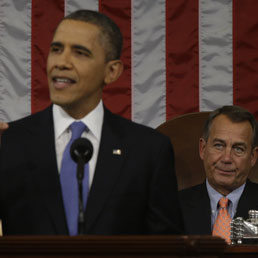Storia dell'articolo
Chiudi
Questo articolo è stato pubblicato il 13 febbraio 2013 alle ore 08:06.

And that has to start at the earliest possible age. Study after study shows that the sooner a child begins learning, the better he or she does down the road. But today, fewer than 3 in 10 four year-olds are enrolled in a high-quality preschool program. Most middle-class parents can't afford a few hundred bucks a week for a private preschool. And for poor kids who need help the most, this lack of access to preschool education can shadow them for the rest of their lives. So tonight, I propose working with states to make high-quality preschool available to every single child in America. (Applause.) That's something we should be able to do.
Every dollar we invest in high-quality early childhood education can save more than seven dollars later on — by boosting graduation rates, reducing teen pregnancy, even reducing violent crime. In states that make it a priority to educate our youngest children, like Georgia or Oklahoma, studies show students grow up more likely to read and do math at grade level, graduate high school, hold a job, form more stable families of their own. We know this works. So let's do what works and make sure none of our children start the race of life already behind. Let's give our kids that chance. (Applause.)
Let's also make sure that a high school diploma puts our kids on a path to a good job. Right now, countries like Germany focus on graduating their high school students with the equivalent of a technical degree from one of our community colleges. So those German kids, they're ready for a job when they graduate high school. They've been trained for the jobs that are there. Now at schools like P-Tech in Brooklyn, a collaboration between New York Public Schools and City University of New York and IBM, students will graduate with a high school diploma and an associate's degree in computers or engineering.
We need to give every American student opportunities like this. (Applause.)
And four years ago, we started Race to the Top — a competition that convinced almost every state to develop smarter curricula and higher standards, all for about 1 percent of what we spend on education each year. Tonight, I'm announcing a new challenge to redesign America's high schools so they better equip graduates for the demands of a high-tech economy. And we'll reward schools that develop new partnerships with colleges and employers, and create classes that focus on science, technology, engineering and math — the skills today's employers are looking for to fill the jobs that are there right now and will be there in the future.
Now, even with better high schools, most young people will need some higher education. It's a simple fact the more education you've got, the more likely you are to have a good job and work your way into the middle class. But today, skyrocketing costs price too many young people out of a higher education, or saddle them with unsustainable debt.
©RIPRODUZIONE RISERVATA









